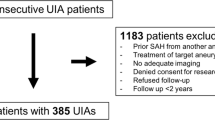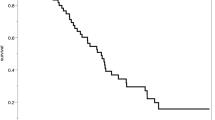Abstract
Background and purpose
The rate of de novo aneurysm formation in patients with unruptured aneurysm without history of subarachnoid hemorrhage is scarcely defined in literature. We report the incidence of de novo aneurysm formation in a large contemporary series of patients with unruptured intracranial aneurysm (UIA) undergoing serial neurovascular imaging.
Methods
Neurovascular imaging studies of 321 consecutive UIA patients with no prior history of subarachnoid hemorrhage, with at least 3 years of follow-up imaging, were reviewed by a neuroradiologist and a neurosurgeon. Rate of de novo aneurysm formation was reported on a per-patient and per-patient-year basis.
Results
Of the 321 included patients, three patients (0.9%) developed a de novo aneurysm over a mean follow-up period of 5.2 years, for an incidence rate of 0.18% per patient-year. No de novo aneurysms ruptured and all three were 2 mm in size.
Conclusions
The rate of de novo aneurysm formation in patients with unruptured aneurysms and no history of subarachnoid hemorrhage is very low. These data are useful to advice patients with unruptured aneurysms from another aneurysm and to plan imaging follow-ups in these patients.

Similar content being viewed by others
References
Backes D, Rinkel GJE, Greving JP, Velthuis BK, Murayama Y, Takao H, Ishibashi T, Igase M, terBrugge KG, Agid R, Jaaskelainen JE, Lindgren AE, Koivisto T, von Und Zu Fraunberg M, Matsubara S, Moroi J, Wong GKC, Abrigo JM, Igase K, Matsumoto K, Wermer MJH, van Walderveen MAA, Algra A, Vergouwen MDI (2017) ELAPSS score for prediction of risk of growth of unruptured intracranial aneurysms. Neurology 88:1600–1606. https://doi.org/10.1212/wnl.0000000000003865
David CA, Vishteh AG, Spetzler RF, Lemole M, Lawton MT, Partovi S (1999) Late angiographic follow-up review of surgically treated aneurysms. J Neurosurg 91:396–401. https://doi.org/10.3171/jns.1999.91.3.0396
Ferns SP, Sprengers ME, van Rooij WJ, van den Berg R, Velthuis BK, de Kort GA, Sluzewski M, van Zwam WH, Rinkel GJ, Majoie CB (2011) De novo aneurysm formation and growth of untreated aneurysms: a 5-year MRA follow-up in a large cohort of patients with coiled aneurysms and review of the literature. Stroke 42:313–318. https://doi.org/10.1161/strokeaha.110.591594
Juvela S, Porras M, Heiskanen O (1993) Natural history of unruptured intracranial aneurysms: a long-term follow-up study. J Neurosurg 79:174–182. https://doi.org/10.3171/jns.1993.79.2.0174
Juvela S, Poussa K, Porras M (2001) Factors affecting formation and growth of intracranial aneurysms: a long-term follow-up study. Stroke 32:485–491
Matsumoto K, Oshino S, Sasaki M, Tsuruzono K, Taketsuna S, Yoshimine T (2013) Incidence of growth and rupture of unruptured intracranial aneurysms followed by serial MRA. Acta Neurochir 155:211–216. https://doi.org/10.1007/s00701-012-1566-z
Miyazawa N, Akiyama I, Yamagata Z (2006) Risk factors for growth of unruptured intracranial aneurysms: follow-up study by serial 0.5-T magnetic resonance angiography. Neurosurgery 58:1047–1053; discussion 1047-1053. https://doi.org/10.1227/01.neu.0000217366.02567.d2
Nasr DM, Brown RD Jr (2016) Management of unruptured intracranial aneurysms. Curr Cardiol Rep 18. https://doi.org/10.1007/s11886-016-0763-4
Phan TG, Huston J 3rd, Brown RD Jr, Wiebers DO, Piepgras DG (2002) Intracranial saccular aneurysm enlargement determined using serial magnetic resonance angiography. J Neurosurg 97:1023–1028. https://doi.org/10.3171/jns.2002.97.5.1023
Rahmah NN, Horiuchi T, Kusano Y, Sasaki T, Hongo K (2011) De novo aneurysm: case reports and literature review. Neurosurgery 69:E761–E766; discussion E766–767. https://doi.org/10.1227/NEU.0b013e3182196489
Serrone JC, Tackla RD, Gozal YM, Hanseman DJ, Gogela SL, Vuong SM, Kosty JA, Steiner CA, Krueger BM, Grossman AW, Ringer AJ (2016) Aneurysm growth and de novo aneurysms during aneurysm surveillance. J Neurosurg 125:1374–1382. https://doi.org/10.3171/2015.12.JNS151552
Sprengers ME, van Rooij WJ, Sluzewski M, Rinkel GJ, Velthuis BK, de Kort GA, Majoie CB (2009) MR angiography follow-up 5 years after coiling: frequency of new aneurysms and enlargement of untreated aneurysms. AJNR Am J Neuroradiol 30:303–307. https://doi.org/10.3174/ajnr.A1353
Tonn J, Hoffmann O, Hofmann E, Schlake HP, Sorensen N, Roosen K (1999) “De novo” formation of intracranial aneurysms: who is at risk? Neuroradiology 41:674–679
van der Schaaf IC, Velthuis BK, Wermer MJ, Majoie C, Witkamp T, de Kort G, Freling NJ, Rinkel GJ (2005) New detected aneurysms on follow-up screening in patients with previously clipped intracranial aneurysms: comparison with DSA or CTA at the time of SAH. Stroke 36:1753–1758. https://doi.org/10.1161/01.STR.0000173160.21182.3b
Wiebers DO, Whisnant JP, Huston J 3rd, Meissner I, Brown RD Jr, Piepgras DG, Forbes GS, Thielen K, Nichols D, O’Fallon WM, Peacock J, Jaeger L, Kassell NF, Kongable-Beckman GL, Torner JC (2003) Unruptured intracranial aneurysms: natural history, clinical outcome, and risks of surgical and endovascular treatment. Lancet (London, England) 362:103–110
Author information
Authors and Affiliations
Corresponding author
Ethics declarations
Conflict of interest
Dr. Giordan, Dr. Brinjikji and Mrs. Vine report no disclosures. Dr. Lanzino reports that he is a consultant with Medtronic.
Ethical approval
All procedures performed in studies involving human participants were in accordance with the ethical standards of the institutional and/or national research committee and with the 1964 Helsinki declaration and its later amendments or comparable ethical standards.
For this type of study formal consent is not required.
Rights and permissions
About this article
Cite this article
Giordan, E., Brinjikji, W., Vine, R.L. et al. Risk of de novo aneurysm formation in patients with unruptured intracranial aneurysms. Acta Neurochir 160, 747–751 (2018). https://doi.org/10.1007/s00701-018-3472-5
Received:
Accepted:
Published:
Issue Date:
DOI: https://doi.org/10.1007/s00701-018-3472-5




